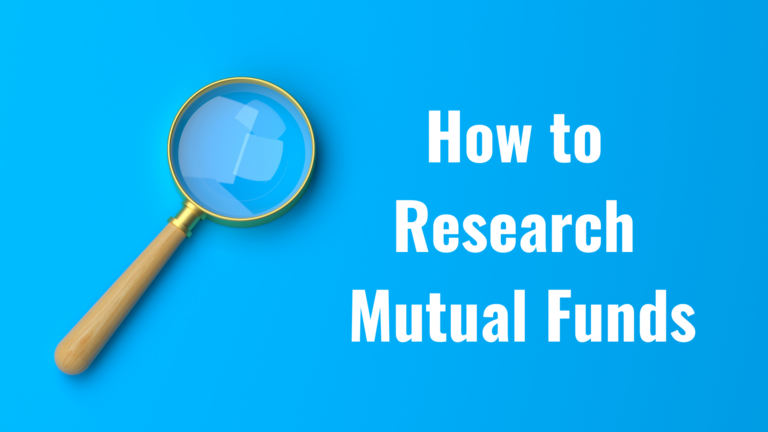So now you know a bit about mutual funds: what they are, how they work, how they can benefit your portfolio, and how they can sometimes charge fees that border on the absurd.
But don’t go thinking you’re a mutual fund master just yet.
There’s a lot of daylight between knowing the basics of mutual funds and actually profiting off that knowledge.
We can’t tell you what to buy, how much to spend, or what you want to do with the shares, but we can help you identify the funds you want to buy, or at least get you started.
The next step is to talk about how to research mutual funds.
Tools Are (Not) For Fools

There are currently around 7,500 mutual funds operating in the US at the end of 2021.
Finding the right mutual funds for your portfolio is like trying to find a needle in a haystack: it’s going to take forever if you do it by hand.
The right combination of tools can make finding good mutual funds significantly easier in the same way that a metal detector and a magnet turn haystack-searching into a 10-minute chore instead of a days-long ordeal.
There are dozens of companies that offer research, recommendations, and search tools you can use to sift through the lists of mutual funds—it’s just a matter of finding the right ones.
For example:
- Zacks: Has a free search tool that lets you search by category and rank, displays a smattering of stats, and includes rating reports produced by Zacks themselves. Read our Zacks review here.
- Fidelity: Lets you search by fund rating, family, fee structure, asset class, and so on.
- Morningstar: Has tons of research on all kinds of different securities. Offers an incredible range of reports and ratings. Some are free, but most are only for subscribers. Read our Morningstar review here.
- Merrill Lynch: Gives you access to educational materials and a comprehensive screening tool that lets you filter by fees, dividends, asset classes, social responsibility, and other variables.
What to Look for in a Mutual Fund

You should keep a few different criteria in mind when you’re deciding whether or not a mutual fund is right for you.
First: Your personal criteria. What’s your risk tolerance? Are you looking to make money in a relatively short time or are you going to hold onto your portfolio for the foreseeable future? What kind of tax burden are you willing to accept?
Having the answers to these questions will make filtering mutual funds much easier.
Second: The fund’s metrics. Consider things like:
- Assets under management (AUM): The size of the fund’s portfolio
- Historical performance: How the fund has performed in previous years
- Performance versus benchmarks: Seeing if the fund has beaten the stock market and other common benchmarks
- Performance relative to similar funds: Comparing the fund’s performance to that of funds with similar focuses, asset mixes, etc.
- Performance of fund manager: Checking out how well the fund manager’s other funds (if any) have performed in the past
- Fee structure: How much the fund charges in yearly fees and commissions
- Portfolio composition: What kind of assets the fund holds
- Portfolio turnover: How often the manager sells assets
Have Fun(d) With It

You can spend days or even weeks perusing all the American mutual funds, let alone the thousands of international funds you can buy into.
It may be tempting to just buy whatever firms like Morningstar or Fidelity recommend, but make sure you do your own due diligence before making the purchase.
It’s not going to be easy. It’s going to take some time. At some point your eyes will glaze over and the numbers will stop making sense.
But after you take a nap and grab some coffee you’ll start to see things in the data that you never expected and, if you’re lucky, you’ll stumble on the exact mutual funds that you need to round out your portfolio and help you on your way to an early retirement.
Now that you know how to research mutual funds on your own, let’s put that knowledge to work in your 401(k).
We are paid subscribers to dozens of stock newsletters. We actively track every recommendation from all of these services, calculate performance, and share the results of the top performing stock newsletters whose subscriptions fees are under $500. The main metric to look for is "Excess Return" which is their return above that of the S&P500. So, based on last 3 years ending June 29, 2025:The Best Stock Newsletters as of June 29, 2025
Ranking of Top Stock Newsletters Based on Last 3 Years of Stock Picks
Rank Stock Newsletter Stock
PicksAverage
ReturnExcess
ReturnPercent
ProfitableMax %
Return1. ![]()
Alpha Picks76 63% 40% 73% 969% Summary: 2 picks/month based on Seeking Alpha's Quant Rating; Retail Price is $499/yr. See details in our Alpha Picks Review. July, 2025 Promotion:
Save $502. ![]()
Moby.co308 43.3% 12.3% 74% 1764% Summary: 60-150 stock picks per year, segmented by industry; Retail Price is $199/yr. Read our Moby Review. July, 2025 Promotion:Next pick free! 3. ![]()
Stock Advisor72 41.2% 6.9% 78% 258% Summary: 2 picks/month and 2 Best Buy Stocks lists focusing on high growth potential stocks over 5 years; Retail Price is $199/yr.
Read our Motley Fool Review.July, 2025 Promotion: Get $100 Off 4. ![]()
Value Investor39 17.5% 6.1% 38% 410% Summary: 10-25 stock picks per year based on Zacks' Quant Rating; Retail Price is $495/yr. Read our Zacks Review. July, 2025 PROMOTION:$1, then $495/yr 5. ![]()
Rule Breakers66 40.0% 4.7% 61% 311% Summary: 2 picks/month focusing on disruptive technology and business models; Lifetime average return of 355% vs S&P500's 149% since 2005; Now part of Motley Fool Epic. Read our Motley Fool Epic Review. Current Promotion: Save $200 6. 
TipRanks SmartInvestor121 10.6% 3.7% 55% 340% Summary: About 1 pick/week focusing on short term trades; Lifetime average return of 355% vs S&P500's 149% since 2015. Retail Price is $379/yr. Read our TipRanks Review. Current Promotion: Save $180 7. 
Action Alerts Plus394 20.0% 3.4% 57% 220% Summary: 100-150 trades per year, lots of buying and selling and short term trades. Read our Jim Cramer Review. Current Promotion: None 8. ![]()
Stock Advisor Canada36 32.3% 0.5% 69% 378% Summary: 1 pick/month from the Toronto stock exchange; Retail Price is CD$199/yr. Read our Motley Fool Canada Stock Advisor Review. July, 2025 Promotion: Save $100 Top Ranking Stock Newsletters based on their last 3 years of stock picks' performance through May 31, 2025 as compared to S&P500. S&P500's return is based on average return of S&P500 from date each stock pick is released. NOTE: To get these results you must buy equal dollar amounts of each pick on the date the stock pick is released. Investor Business Daily Top 50 based on performance of FFTY ETF.
